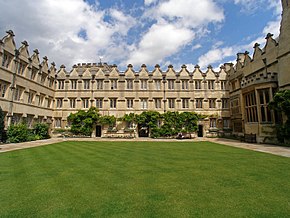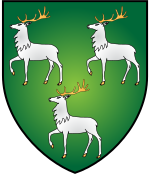Jesus College Oxford
| Jesus College | |
|---|---|
 |
|

Blazon: Vert, three stags trippant argent attired or.
|
|
| University | Oxford |
| Location | Turl Street |
| Coordinates | 51°45′12″N 1°15′25″W / 51.753422°N 1.256968°WCoordinates: 51°45′12″N 1°15′25″W / 51.753422°N 1.256968°W |
| Full name | Jesus College in the University of Oxford of Queen Elizabeth's Foundation |
| Latin name | Collegium Ihesus |
| Established | 1571 |
| Named for | Jesus of Nazareth |
| Sister college | Jesus College, Cambridge |
| Principal | Sir Nigel Shadbolt |
| Undergraduates | 352 |
| Postgraduates | 150 |
| Website | www |
| Boat club | Boat Club website |
| Map | |
Jesus College (in full: Jesus College in the University of Oxford of Queen Elizabeth's Foundation) is one of the colleges of the University of Oxford in England. It is in the centre of the city, on a site between Turl Street, Ship Street, Cornmarket Street and Market Street. The college was founded by Elizabeth I on 27 June 1571 for the education of clergy, though students now study a broad range of secular subjects. A major driving force behind the establishment of the college was Hugh Price (or Ap Rhys), a churchman from Brecon in Wales. The oldest buildings, in the first quadrangle, date from the 16th and early 17th centuries; a second quadrangle was added between about 1640 and about 1713, and a third quadrangle was built in about 1906. Further accommodation was built on the main site to mark the 400th anniversary of the college, in 1971, and student flats have been constructed at sites in north and east Oxford.
The life of the college was disrupted by the English Civil War. Leoline Jenkins, who became principal after the war in 1661, put the college on a more stable financial footing. Little happened at the college during the 18th century, and the 19th century saw a decline in numbers and academic standards. Reforms of Oxford University after two Royal Commissions in the latter half of the 19th century led to removal of many of the restrictions placed on the college's fellowships and scholarships, such that the college ceased to be predominantly full of Welsh students and academics. Students' academic achievements rose in the early 20th century as fellows were appointed to teach in new subjects. Women were first admitted in 1974 and now form a large part of the undergraduate population.
...
Wikipedia

